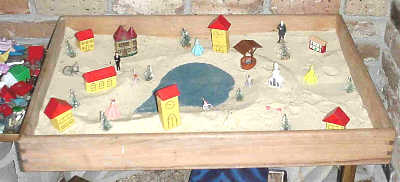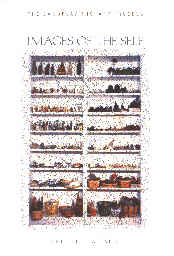Sandplay therapy consists of a person sitting in front of a 30.5" by 20.5" by 3" tray of sand
covering a blue bottom and arranging the sand and figures in the sand to form a scene. The scene is
created in this miniature "temenos" or sacred place in silence with only occasional comments or
questions by the analyst. At the end of the sandplay production, a photo is taken and the creator is
allowed to describe the scene. the figures are chosen from a large variety of objects: trees, dolphins,
Buddhas, Mexicans, farmers, bridges, rocks, pine cones, canoeists, string, etc.  The blue bottom
serves as convenient water areas - ponds, lakes, and rivers can be formed by removing sand from the
bottom. The sessions may take place weekly with an occasional hiatus for verbal development and
the photographic slides are saved for a final review session when the therapy concludes. At right is an official size sandplay box with the design by a normal twelve year old girl.
The blue bottom
serves as convenient water areas - ponds, lakes, and rivers can be formed by removing sand from the
bottom. The sessions may take place weekly with an occasional hiatus for verbal development and
the photographic slides are saved for a final review session when the therapy concludes. At right is an official size sandplay box with the design by a normal twelve year old girl.
Weinrib recommends sand play for clients who are making little or no progress in verbal therapies. A client who backs away from growth when confronted with its possibility can be expected to create in the sand play process a three dimensional work that displays the reluctance or resistance so graphically that the message can rise into consciousness and thence into words. For depressed patients, one trip to the sandbox can result in change simply because they will have created something - done something, sometimes for the first time in months. Later the insights will come, but the patient may brighten simple in the action of completing the first scene.
Weinrib takes us through a case in the second half of the book. the client is a male who is stuck with deep father issues that he has carefully sidestepped up until now. As we follow the scenes he creates in successive sessions, we can experience the development of his consciousness and ego strength.
All we can say after reading her book is "Come on in, the sand is fine."
For more information on Sand Play in therapy see my review of Sand Play .
~~~~~~~~~~~~~~~~~~~~~~~~~~~~~~~~~~~~~~~~~~~~~~~~~~~~~~~~~~
 ~~~~~~~~~~~~~~~~~~~~~~~~~~~~~~~~~~~~~~~~~~~~~~~~~~~~~~
~~~~~~~~~~~~~~~~~~~~~~~~~~~~~~~~~~~~~~~~~~~~~~~~~~~~~~



